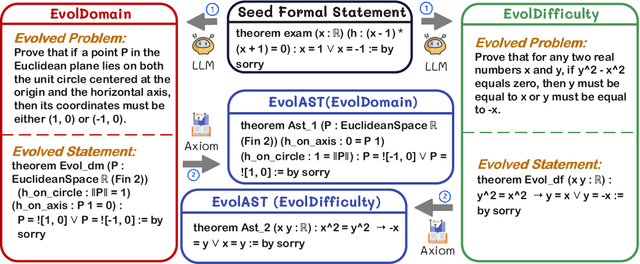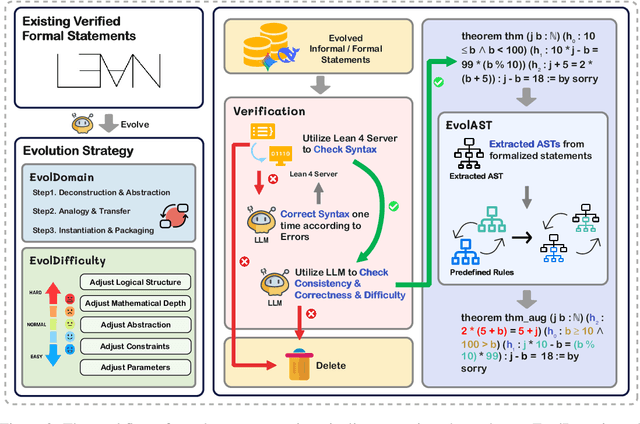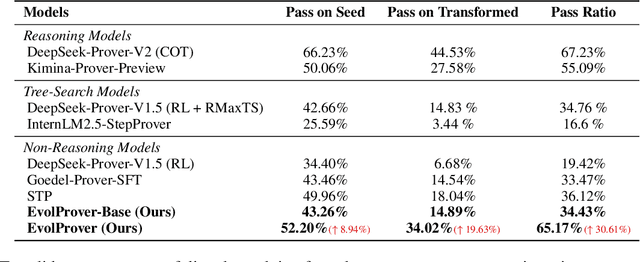Automated Theorem Proving
The goal of automated theorem proving is to automatically generate a proof, given a conjecture (the target theorem) and a knowledge base of known facts, all expressed in a formal language. Automated theorem proving is useful in a wide range of applications, including the verification and synthesis of software and hardware systems.
Papers and Code
MSC-180: A Benchmark for Automated Formal Theorem Proving from Mathematical Subject Classification
Dec 20, 2025Automated Theorem Proving (ATP) represents a core research direction in artificial intelligence for achieving formal reasoning and verification, playing a significant role in advancing machine intelligence. However, current large language model (LLM)-based theorem provers suffer from limitations such as restricted domain coverage and weak generalization in mathematical reasoning. To address these issues, we propose MSC-180, a benchmark for evaluation based on the MSC2020 mathematical subject classification. It comprises 180 formal verification problems, 3 advanced problems from each of 60 mathematical branches, spanning from undergraduate to graduate levels. Each problem has undergone multiple rounds of verification and refinement by domain experts to ensure formal accuracy. Evaluations of state-of-the-art LLM-based theorem provers under the pass@32 setting reveal that the best model achieves only an 18.89% overall pass rate, with prominent issues including significant domain bias (maximum domain coverage 41.7%) and a difficulty gap (significantly lower pass rates on graduate-level problems). To further quantify performance variability across mathematical domains, we introduce the coefficient of variation (CV) as an evaluation metric. The observed CV values are 4-6 times higher than the statistical high-variability threshold, indicating that the models still rely on pattern matching from training corpora rather than possessing transferable reasoning mechanisms and systematic generalization capabilities. MSC-180, together with its multi-dimensional evaluation framework, provides a discriminative and systematic benchmark for driving the development of next-generation AI systems with genuine mathematical reasoning abilities.
Gödel's Poetry
Dec 16, 2025Formal, automated theorem proving has long been viewed as a challenge to artificial intelligence. We introduce here a new approach to computer theorem proving, one that employs specialized language models for Lean4 proof generation combined with recursive decomposition of difficult theorems into simpler entailing propositions. These models are coordinated through a multi-agent architecture that orchestrates autoformalization (if required), proof generation, decomposition of difficult theorems into simpler entailing propositions, and recursive proof (and/or decomposition) of these propositions. Without decomposition, we achieve a 90.4% pass rate on miniF2F. With decomposition, this is significantly improved. A key technical contribution lies in our extension of the Kimina Lean Server with abstract syntax tree (AST) parsing capabilities to facilitate automated, recursive proof decomposition. The system is made available on PyPI as goedels-poetry (at https://pypi.org/project/goedels-poetry ), and the open-source implementation KellyJDavis/goedels-poetry (at https://github.com/KellyJDavis/goedels-poetry ) facilitates both adaptation to alternative language models and extension with custom functionality.
MiniF2F-Dafny: LLM-Guided Mathematical Theorem Proving via Auto-Active Verification
Dec 11, 2025We present miniF2F-Dafny, the first translation of the mathematical reasoning benchmark miniF2F to an automated theorem prover: Dafny. Previously, the benchmark existed only in interactive theorem provers (Lean, Isabelle, HOL Light, Metamath). We find that Dafny's automation verifies 99/244 (40.6%) of the test set and 109/244 (44.7%) of the validation set with empty proofs--requiring no manual proof steps. For problems where empty proofs fail, we evaluate 12 off-the-shelf LLMs on providing proof hints. The best model we test achieves 55.7% pass@4 success rate employing iterative error correction. These preliminary results highlight an effective division of labor: LLMs provide high-level guidance while automation handles low-level details. Our benchmark can be found on GitHub at http://github.com/dafny-lang/miniF2F .
Spark-Prover-X1: Formal Theorem Proving Through Diverse Data Training
Nov 18, 2025Large Language Models (LLMs) have shown significant promise in automated theorem proving, yet progress is often constrained by the scarcity of diverse and high-quality formal language data. To address this issue, we introduce Spark-Prover-X1, a 7B parameter model trained via an three-stage framework designed to unlock the reasoning potential of more accessible and moderately-sized LLMs. The first stage infuses deep knowledge through continuous pre-training on a broad mathematical corpus, enhanced by a suite of novel data tasks. Key innovation is a "CoT-augmented state prediction" task to achieve fine-grained reasoning. The second stage employs Supervised Fine-tuning (SFT) within an expert iteration loop to specialize both the Spark-Prover-X1-7B and Spark-Formalizer-X1-7B models. Finally, a targeted round of Group Relative Policy Optimization (GRPO) is applied to sharpen the prover's capabilities on the most challenging problems. To facilitate robust evaluation, particularly on problems from real-world examinations, we also introduce ExamFormal-Bench, a new benchmark dataset of 402 formal problems. Experimental results demonstrate that Spark-Prover achieves state-of-the-art performance among similarly-sized open-source models within the "Whole-Proof Generation" paradigm. It shows exceptional performance on difficult competition benchmarks, notably solving 27 problems on PutnamBench (pass@32) and achieving 24.0\% on CombiBench (pass@32). Our work validates that this diverse training data and progressively refined training pipeline provides an effective path for enhancing the formal reasoning capabilities of lightweight LLMs. Both Spark-Prover-X1-7B and Spark-Formalizer-X1-7B, along with the ExamFormal-Bench dataset, are made publicly available at: https://www.modelscope.cn/organization/iflytek, https://gitcode.com/ifly_opensource.
An Automated Theorem Generator with Theoretical Foundation Based on Rectangular Standard Contradiction
Nov 06, 2025Currently, there is a lack of rigorous theoretical system for systematically generating non-trivial and logically valid theorems. Addressing this critical gap, this paper conducts research to propose a novel automated theorem generation theory and tool. Based on the concept of standard contradiction which possesses unique deductive advantages, this paper defines and proves, for the first time, a new logical structure known as rectangular standard contradiction. Centered on this structure, a complete Automated Theorem Generation (ATG) theory is put forward. Theoretical proofs clarify two core properties of rectangular standard contradiction: first, it is a standard contradiction (necessarily unsatisfiable); second, it exhibits non-redundancy (the remaining clause set becomes satisfiable after removing any clause). Leveraging these properties, this paper proves that partitioning a rectangular standard contradiction into a premise subset $A$ and negation of its complement $H$, a valid theorem $A \vdash \neg H$ can be formed, and all such theorems are logically equivalent. To implement this theory, an efficient template-based ATG algorithm is designed, and a Rectangular Automated Theorem Generator is developed. This research enables machines to transition from "verifiers" to "discoverers", opening up new avenues for fundamental research in the fields of logic and artificial intelligence.
An Operational Kardashev-Style Scale for Autonomous AI - Towards AGI and Superintelligence
Nov 17, 2025We propose a Kardashev-inspired yet operational Autonomous AI (AAI) Scale that measures the progression from fixed robotic process automation (AAI-0) to full artificial general intelligence (AAI-4) and beyond. Unlike narrative ladders, our scale is multi-axis and testable. We define ten capability axes (Autonomy, Generality, Planning, Memory/Persistence, Tool Economy, Self-Revision, Sociality/Coordination, Embodiment, World-Model Fidelity, Economic Throughput) aggregated by a composite AAI-Index (a weighted geometric mean). We introduce a measurable Self-Improvement Coefficient $κ$ (capability growth per unit of agent-initiated resources) and two closure properties (maintenance and expansion) that convert ``self-improving AI'' into falsifiable criteria. We specify OWA-Bench, an open-world agency benchmark suite that evaluates long-horizon, tool-using, persistent agents. We define level gates for AAI-0\ldots AAI-4 using thresholds on the axes, $κ$, and closure proofs. Synthetic experiments illustrate how present-day systems map onto the scale and how the delegability frontier (quality vs.\ autonomy) advances with self-improvement. We also prove a theorem that AAI-3 agent becomes AAI-5 over time with sufficient conditions, formalizing "baby AGI" becomes Superintelligence intuition.
Learning Interestingness in Automated Mathematical Theory Formation
Nov 05, 2025We take two key steps in automating the open-ended discovery of new mathematical theories, a grand challenge in artificial intelligence. First, we introduce $\emph{FERMAT}$, a reinforcement learning (RL) environment that models concept discovery and theorem-proving using a set of symbolic actions, opening up a range of RL problems relevant to theory discovery. Second, we explore a specific problem through $\emph{FERMAT}$: automatically scoring the $\emph{interestingness}$ of mathematical objects. We investigate evolutionary algorithms for synthesizing nontrivial interestingness measures. In particular, we introduce an LLM-based evolutionary algorithm that features function abstraction, leading to notable improvements in discovering elementary number theory and finite fields over hard-coded baselines. We open-source the $\emph{FERMAT}$ environment at this URL(https://github.com/trishullab/Fermat).
Ax-Prover: A Deep Reasoning Agentic Framework for Theorem Proving in Mathematics and Quantum Physics
Oct 14, 2025We present Ax-Prover, a multi-agent system for automated theorem proving in Lean that can solve problems across diverse scientific domains and operate either autonomously or collaboratively with human experts. To achieve this, Ax-Prover approaches scientific problem solving through formal proof generation, a process that demands both creative reasoning and strict syntactic rigor. Ax-Prover meets this challenge by equipping Large Language Models (LLMs), which provide knowledge and reasoning, with Lean tools via the Model Context Protocol (MCP), which ensure formal correctness. To evaluate its performance as an autonomous prover, we benchmark our approach against frontier LLMs and specialized prover models on two public math benchmarks and on two Lean benchmarks we introduce in the fields of abstract algebra and quantum theory. On public datasets, Ax-Prover is competitive with state-of-the-art provers, while it largely outperform them on the new benchmarks. This shows that, unlike specialized systems that struggle to generalize, our tool-based agentic theorem prover approach offers a generalizable methodology for formal verification across diverse scientific domains. Furthermore, we demonstrate Ax-Prover's assistant capabilities in a practical use case, showing how it enabled an expert mathematician to formalize the proof of a complex cryptography theorem.
Autoformalizer with Tool Feedback
Oct 08, 2025



Autoformalization addresses the scarcity of data for Automated Theorem Proving (ATP) by translating mathematical problems from natural language into formal statements. Efforts in recent work shift from directly prompting large language models to training an end-to-end formalizer model from scratch, achieving remarkable advancements. However, existing formalizer still struggles to consistently generate valid statements that meet syntactic validity and semantic consistency. To address this issue, we propose the Autoformalizer with Tool Feedback (ATF), a novel approach that incorporates syntactic and consistency information as tools into the formalization process. By integrating Lean 4 compilers for syntax corrections and employing a multi-LLMs-as-judge approach for consistency validation, the model is able to adaptively refine generated statements according to the tool feedback, enhancing both syntactic validity and semantic consistency. The training of ATF involves a cold-start phase on synthetic tool-calling data, an expert iteration phase to improve formalization capabilities, and Direct Preference Optimization to alleviate ineffective revisions. Experimental results show that ATF markedly outperforms a range of baseline formalizer models, with its superior performance further validated by human evaluations. Subsequent analysis reveals that ATF demonstrates excellent inference scaling properties. Moreover, we open-source Numina-ATF, a dataset containing 750K synthetic formal statements to facilitate advancements in autoformalization and ATP research.
EvolProver: Advancing Automated Theorem Proving by Evolving Formalized Problems via Symmetry and Difficulty
Oct 01, 2025



Large Language Models (LLMs) for formal theorem proving have shown significant promise, yet they often lack generalizability and are fragile to even minor transformations of problem statements. To address this limitation, we introduce a novel data augmentation pipeline designed to enhance model robustness from two perspectives: symmetry and difficulty. From the symmetry perspective, we propose two complementary methods: EvolAST, an Abstract Syntax Tree (AST) based approach that targets syntactic symmetry to generate semantically equivalent problem variants, and EvolDomain, which leverages LLMs to address semantic symmetry by translating theorems across mathematical domains. From the difficulty perspective, we propose EvolDifficulty, which uses carefully designed evolutionary instructions to guide LLMs in generating new theorems with a wider range of difficulty. We then use the evolved data to train EvolProver, a 7B-parameter non-reasoning theorem prover. EvolProver establishes a new state-of-the-art (SOTA) on FormalMATH-Lite with a 53.8% pass@32 rate, surpassing all models of comparable size, including reasoning-based models. It also sets new SOTA records for non-reasoning models on MiniF2F-Test (69.8% pass@32), Ineq-Comp-Seed (52.2% pass@32), and Ineq-Comp-Transformed (34.0% pass@32). Ablation studies further confirm our data augmentation pipeline's effectiveness across multiple benchmarks.
 Add to Chrome
Add to Chrome Add to Firefox
Add to Firefox Add to Edge
Add to Edge